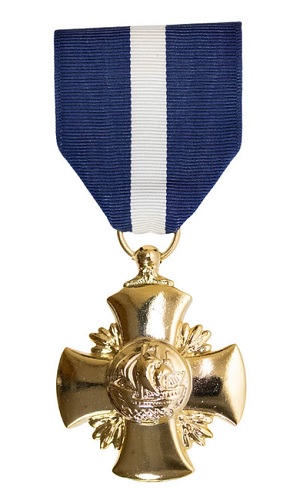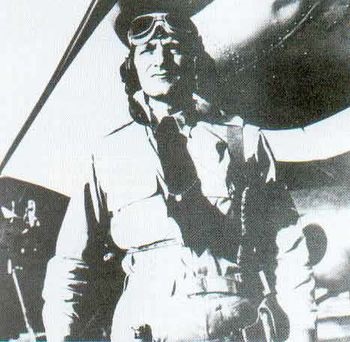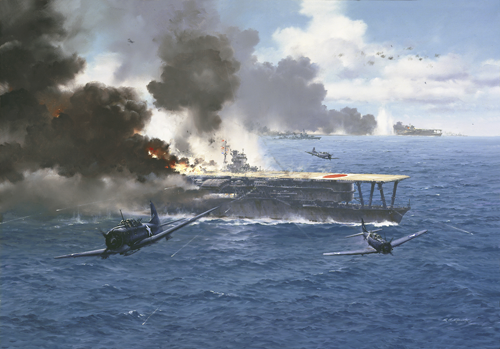Battle of Midway
June 4 - 7 1942
History Channel's Battle of Midway site
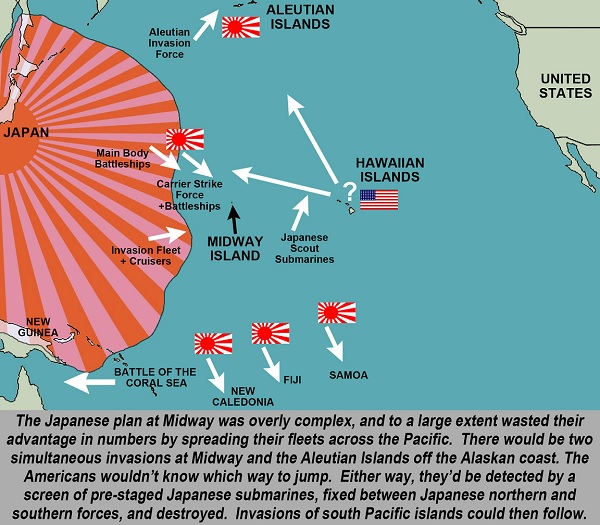
Ships
& Aircraft of the Battle of Midway Excellent
detailed descriptions
of all ships and planes. lncludes Order of Battle and maps.
Watch this video about John C. Waldron!
Lt
Commander J C Waldron, USN. Commander, Torpedo
Squadron 8,
USS Hornet (CV-8). Navy Cross (Posthumous). Killed in action, Battle
of Midway.
Graduate of Rapid City High School, Class of 1920; US Naval Academy, Class
of 1924. His mother was Oglala
Lakota. She taught him the traditions of The People.
He grew up on a ranch near Pierre, South Dakota.
He knew his 15 old and slow aircraft stood zero chance against
the fast and
nimble Japanese fighters that would try to stop them. He told his pilots:
"I want each of us to do his utmost to destroy our enemies.
If there is only one plane left, I want that man to go in and get a hit.
May God be with us all. Good Luck, happy landings, and give 'em hell."
All of Torpedo 8's planes were shot down. Only one man survived.
Only five TBDs from the other two carriers survived the battle.
Lest We Forget
Here is a photo of Midway atoll today, from overhead
Three paintings from the art collection of the US Navy. Click on the paintings to find out more.
"Coming Aboard" (left) and "Task Force Hornets" (right) by L. B. Smith
(left) SBD dive bombers returning from an attack. Captain Marc Mitscher in the foreground.
(right) F4F Wildcat fighters parked ("spotted")
while pilots (in yellow) discuss tactics.
(Fighter pilots talk with their hands a lot.)
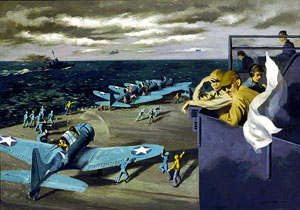
![]()
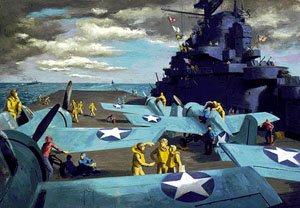
"Famous Four Minutes" by R. G. Smith
Three Japanese aircraft carriers set on fire - 1030, 4 June 1942
SBD "Dauntless" dive bombers from carriers Enterprise (CV-6), and Yorktown (CV-5), made this attack. Click on the picture to find out about Lieutenant Commander Wade McCluskey, who (like LtCdr Waldron from Hornet CV-8) found the Japanese carriers, led the dive bomber attack, and was awarded the Navy Cross.
The USS Yorktown (CV-5), first aircraft carrier and third US Naval vessel of that name, was sunk in this battle. A new USS Yorktown (CV-10), second carrier and fourth naval vessel of that name, went into action in April 1943, was in 11 major battles, and survived the war.
Battle of Midway Art Chronology Five pages of art and historical commentary about the battle. Lots of paintings and action photos. Excellent resource.
The three aircraft types used by the American aircraft carriers at Midway:
.jpg)
"At the Battle of Midway only six of the
41 TBDs launched from the carriers
Yorktown (CV-5), Enterprise (CV-6), and Hornet (CV-8) to attack the Japanese
carrier force returned to their carriers- two from VT-3 to the Yorktown, four
from VT-6
to the Enterprise, and none from VT-8 to the Hornet." The TBDs were replaced
by
the much better TBF
Avengers as fast as American factories could crank
them out.

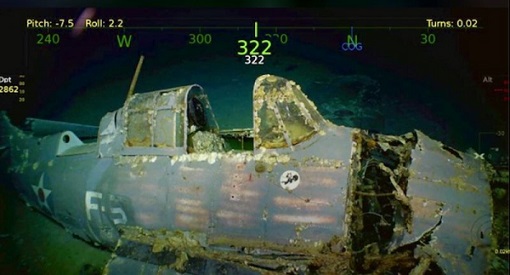
Here's an F4F Wildcat fighter from carrier Yorktown, with its
"Felix the Cat" logo still
visible; found at the wreck of the Lexington. It landed on the wrong ship,
maybe by accident,
maybe out of gas? See where parts have been taken off and used on another
F4F.
In aircraft maintenance, this is called "cannibalizing", or "canning"
for short.
There were aircraft from Lexington on Yorktown at Midway, too.
Click on the aircraft above to find out more
about Jimmy Thach.
He invented the "Thach
Weave" maneuver that let F4Fs like this one fight Zeroes without
getting killed.
It was a low speed version of the "scissors" maneuver that jet fighters
use today.
"For the first time Lt. Commander Tadashi Nakajima (75 kills) encountered what was to become a famous double-team maneuver on the part of the enemy. Two Wildcats jumped on the commander's plane. He had no trouble in getting on the tail of an enemy fighter, but never had a chance to fire before the Grumman's team-mate roared at him from the side. Nakajima was raging when he got back to Rabaul; he had been forced to dive and run for safety." - Saburo Sakai, Japanese ace.
The three aircraft types used by the Japanese aircraft carriers at Midway:
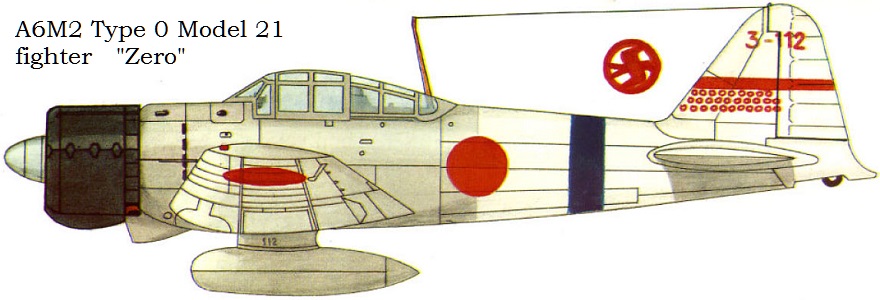
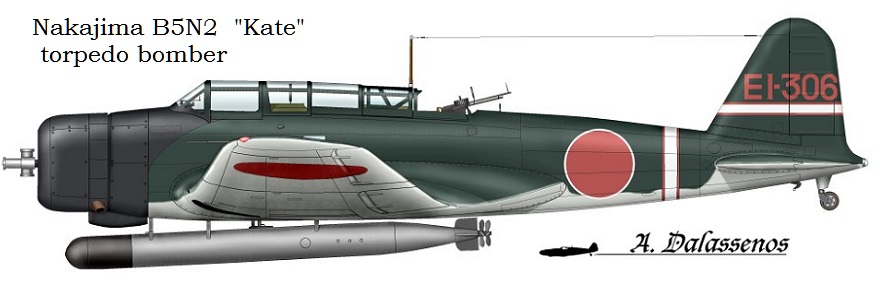
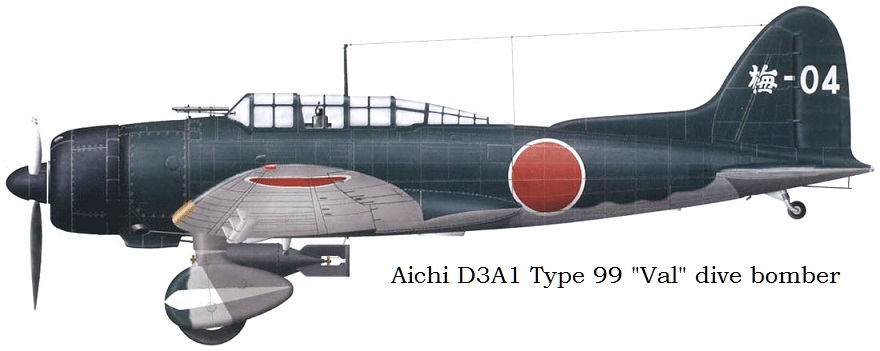
![]() to top of page
to top of page ![]()
![]() to Good Sites
to Good Sites![]()
![]() to History
to History

